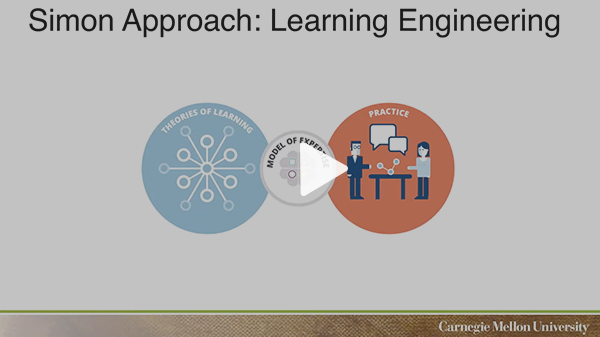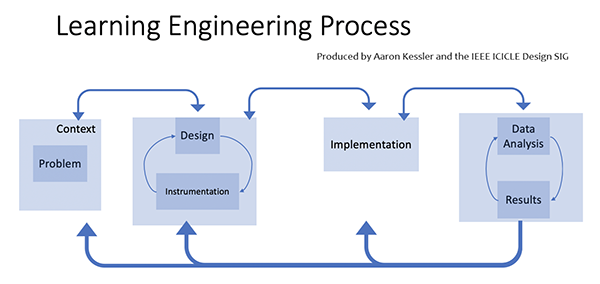Bringing TOPkit Digest to You
|
|
Contents of this Digest:
- Video Tip: The Learning Engineering Process
- Announcements: Registration Deadlines Approaching! TOPkit Workshop 2021 and Innovation Summit 2021
- Top Tips: Framing the Learning Engineering Process
- From the Community: What is Learning Engineering?
- Call for Contributions: Share Your Expertise
- Top Community Topics
|
|
Wrapping Your Head Around the Learning Engineering Process
The More You Play It, the More It Sticks |
|
|

|
|
Carnegie Melon University shares “The Simon Approach to Learning Engineering,” hallmarked by a process that begins with a model of expertise produced from a learning theory, which, having been instrumented for data collection around student learning, is used in an instructional setting. The data are then used to improve the instructional model, which helps the domain continue to advance.
CMU-OLI (description written by James R. Paradiso, adapted from video)
|
|
Framing the Learning Engineering Process
|
|
|
|
While the term “learning engineer” dates back to some 50 years ago when Herb Simon used it to describe professional designers of learning environments, the learning engineering (LE) domain is still evolving quite a bit. Part of what makes this process such a complex endeavor to grapple with is that it looks to solve problems that require diverse skillsets and a shared understanding in the learning and data sciences, instructional design, software engineering, assessment/measurement, et al. as well as expertise in any number of academic disciplines—qualities often distributed across teams of people rather than an individual. To begin assembling a theoretical and working knowledge of the topic, a diagram developed by the IEEE ICICLE Design SIG and some thoughts on how to interpret it will be used to frame LE process and practice.
|
|
|
|
|
|
|
|
|
#1 - Define the problem and problem space. No problem or challenge exists devoid of a context layered in nuanced values associated with learners ‘doing’ learning (and all the complexity that brings) along with the physical, technological, fiscal et al. resources available to work on a viable solution. Making clear connections between these elements is key to getting started.
|
|
#2 - Construct a team. While a team is certainly not required to carry out the LE process, in many cases, the work benefits from having experts in the areas of assessment and evaluation, learning design (and learning sciences), data science, and, of course, subject-matter expertise to collaborate concurrently on all the stages of the LE process. Working as a cohesive team (i.e., collective) from start to finish may seem a bit excessive (or too complex to manage), but addressing any given problem(s) holistically rather than dividing it into (individual) component parts is a strength of the LE approach.
|
|
#3 - Engage in iterative, intentionally instrumented design cycles. An important takeaway for this part of the process is to create design goals that include purposeful instrumentation that measures the learner and content performance. This process involves deciding on a question (for whom and why), a method and metric (how to calculate), the data needed (from where), and whether that data has integrity (measures as intended). | |
#4 - Collect data from instrumented design implementation. Data is collected throughout the implementation, yet rather than discarding outlier data as potential system ‘noise,’ LE seeks to embrace the non-linear complexity of learner (interaction) trajectories, which, in practice, results in a more inclusive approach to implementing design solutions in diverse learning contexts and settings. Keep in mind, however, that while quantitative measures of question response accuracy, for example, are important, consider measures of non-academic (socio-emotional) performance, too, as these matters also impact learner success.
#5 - Analyze the data to evaluate efficacy. Exploring learning outcomes through data analysis may result in more questions than answers (and may involve multiple rounds of analysis), but this iterative, evidence-based approach reveals what to do next (to an extent).
#6 - Iterate based on data insights and perceived gaps. The need to revisit all or some of the previous parts of this process (post data collection and analysis) is highly likely due to areas in which evidence warrants the need for improvement(s).
*This work is an adaptation of the IEEE ICICLE “The Learning Engineering Process” CC BY-NC-SA 4.0.
|
|
|
James R. Paradiso, M.Ed., Instructional Designer and Program Coordinator, Center for Distributed Learning, University of Central Florida (james.paradiso@ucf.edu)
|
|
What Is Learning Engineering?
|
|
|
|
 | |
Take a listen to some of the work being done by a multi-disciplinary team of volunteers working together through the Industry Connections Industry Consortium on Learning Engineering (ICICLE) group to build on the empirical and practical foundations in the field of learning engineering.
|
|
|
James R. Paradiso, M.Ed., Instructional Designer and Program Coordinator, Center for Distributed Learning, University of Central Florida (james.paradiso@ucf.edu)
|
|
Be a Part of the TOPkit Community
|
|
|
|
| |
 |
TOPkit aims at offering adoptable and adaptable guidance and resources to those responsible for faculty development or those who guide faculty to teach online or hybrid courses. As such, we are always looking for novel ways to enhance the practices of those collaborating with faculty to ensure effective online and hybrid courses. What expertise can you share in areas of planning, developing, or evaluating?
Read the contribution by Charlotte Jones-Roberts, M.A. and Roslyn Miller, Ph.D., both Instructional Designers at the University of Central Florida, about Humanizing Online Learning.
|
|
|
References for Top Tips:
Aaron Kessler and the IEEE ICICLE Design SIG. (2020). The Learning Engineering Process. https://sagroups.ieee.org/icicle/learning-engineering-process/ Carnegie Mellon University's Dietrich College of Humanities and Social Sciences. (2018, March 14). A Transformation to Learning Engineering [Video]. https://youtu.be/FajOrOQocEM?t=265 Goodell, J., Kessler, A., Kurzweil, D., Koldner, J. (2020.) Competencies of Learning Engineering Teams and Team Members. In IEEE ICICLE proceedings of the 2019 Conference on Learning Engineering, Arlington, VA, May 2019. IEEE ICICLE. (n.d.). Resources. https://sagroups.ieee.org/icicle/resources/ Simon, H. A. (1967). Job of a college president. Educational Record, 48(1), 68-78.
|
|
Content Coordinator and Contributor
James R. Paradiso, M.Ed., Instructional Designer and Program Coordinator, Center for Distributed Learning, University of Central Florida (james.paradiso@ucf.edu) Editors
Bren Bedford, MNM, Web Project Analyst, Center for Distributed Learning, University of Central Florida
Samantha Richardson, B.A. English, Communications Specialist, Pegasus Innovation Lab, Center for Distributed Learning, University of Central Florida
|
|
|




